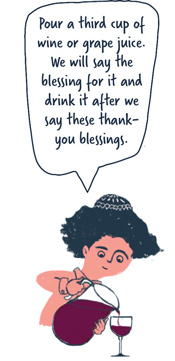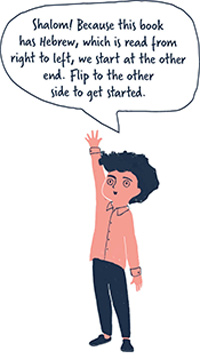The Passover seder is storytelling at its best: a cliffhanger tale told through reading, singing, tasting, showing, and questioning. This multi-dimensional approach has helped generations to appreciate the Passover story – the bitterness of slavery, the rushed escape from the oppressive Pharaoh, the dramatic parting of the Sea of Reeds, and our connection to the Almighty and our redemption. We finish the seder more appreciative, more hopeful, and more committed to the ideals of freedom.
In some cases, we also finish the seder with kids sleeping in their chairs or playing games under the table. There are many opportunities for kids to be involved in the seder, but keeping their attention can be a challenge. The Haggadah, a guide to the seder, reminds the adults to tailor our explanations in different ways to speak to different kinds of children. And yet, parents still sometimes struggle through their seders, wishing for a more accessible Haggadah that works for the e ntire family.
ntire family.
We are fortunate to be able to collaborate with the Next-Gen Advisory Board, a talented advisory committee that helps shape PJ Library. We gather together quarterly to test ideas with this group of young thinkers and creators. It was during these meetings that the PJ Library Haggadah started taking shape. We provided Next-Gen with a small budget, and off they went – researching the market and developing a virtual creative team (which included an illustrator in Israel, a graphic designer in Massachusetts, and content experts in New York), all while communicating with the PJ Library professional team for guidance and feedback. Read on to learn about just a few of the considerations Next-Gen made as they developed the PJ Library Haggadah.
Producing an accessible Haggadah for PJ Library families was a challenge. Drawing on the traditional Haggadah’s timeless values, however, helped guide the process — and will surely continue to influence future revisions. After all, to stay relevant for every generation, the PJ Library Haggadah will need to keep evolving.
Right to Left. First, we imagined the experience of first-time sede r participants encountering strange new words and concepts. The Haggadah, like every traditional Jewish book with Hebrew text, opens from right to left, which could be confusing right from the start. This is why the last page (which would be the first page of an English-language book) features characters who welcome readers and gently guide them to flip the book over.
r participants encountering strange new words and concepts. The Haggadah, like every traditional Jewish book with Hebrew text, opens from right to left, which could be confusing right from the start. This is why the last page (which would be the first page of an English-language book) features characters who welcome readers and gently guide them to flip the book over.
More Than Words. Our Israeli illustrator created vivid depictions of ancient scenes with spirited characters (mostly children) who reappear throughout, interacting with the text around them. These whimsical details, which appeal both to the very young and the young at heart, let kids who can’t yet read experience the richness of the seder along with everyone else.
Attention Spans and Bedtimes. It’s important for the Haggadah to deepen Jewish literacy and provide rich content for families, but 5-year-olds can’t make it through everything. We culled essential seder elements to keep the pace flowing while maintaining the integrity of the traditional text.
Structure. To strengthen narrative cohesion, we divided the PJ Library Haggadah text into four sections: Welcome, The Story, The Special Meal, and Celebrate. Within this structure, the PJ Library Haggadah presents the seder as a time warp, transporting participants back to a night in ancient Egypt when Jews had to decide if they were ready for redemption. As illustrations depict characters setting the seder table with pyramids in the background, the prose asks: “Wait, where are we now?”